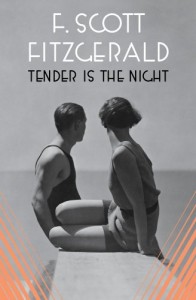 Francis Scott Fitzgerald completed Tender Is The Night in 1934, six years before a heart attack took his life prematurely, to the surprise of no one who was familiar with his drinking habits. It was his last finished novel. His correspondence up to the date of publication reveal his anxieties about it, his difficulties writing and transcending his “unholy depressions,” and the extent to which he draws upon people and experiences from his own life. “If you liked The Great Gatsby,” he wrote to a friend, “for God’s sake read this. Gatsby was a tour de force but this is a confession of faith.” And it is. The Great Gatsby is the consummate novel, airtight, a marvel of form and economy, unrelentingly leading us to the end we can foresee but cannot accept or abide. Tender Is The Night, on the other hand, is scattered, less controlled and focused (a symptom, perhaps, of his failing health or his worsening financial circumstances). The title is borrowed from John Keats’ “Ode to a Nightingale,” evokative of mortality and human frailty, and inspired in no small part by the death of Keats’ younger brother Thomas from tuberculosis and Keats’ intuitions about his own impending tubercular demise.
Francis Scott Fitzgerald completed Tender Is The Night in 1934, six years before a heart attack took his life prematurely, to the surprise of no one who was familiar with his drinking habits. It was his last finished novel. His correspondence up to the date of publication reveal his anxieties about it, his difficulties writing and transcending his “unholy depressions,” and the extent to which he draws upon people and experiences from his own life. “If you liked The Great Gatsby,” he wrote to a friend, “for God’s sake read this. Gatsby was a tour de force but this is a confession of faith.” And it is. The Great Gatsby is the consummate novel, airtight, a marvel of form and economy, unrelentingly leading us to the end we can foresee but cannot accept or abide. Tender Is The Night, on the other hand, is scattered, less controlled and focused (a symptom, perhaps, of his failing health or his worsening financial circumstances). The title is borrowed from John Keats’ “Ode to a Nightingale,” evokative of mortality and human frailty, and inspired in no small part by the death of Keats’ younger brother Thomas from tuberculosis and Keats’ intuitions about his own impending tubercular demise.
The novel tells the story of Dick Diver, a promising young psychiatrist, and his beautiful but mentally unstable wife, Nicole, whose wealth enables them to live a life of luxury and ease on the French Riviera. It is there that the couple meets Rosemary Hoyt, a young and beautiful actress whose growing infatuation with Dick creates, or perhaps merely exposes, a chasmic rift between Dick and Nicole. Fitzgerald uses flashbacks to narrate the backstory of the Diver marriage, which was blamed for the book’s cool reception and led to the creation of a second, edited by Malcolm Cowley based upon notes Fitzgerald prepared before his death, which presented the novel in chronological order. In my humble opinion, however, the flashbacks heighten the drama by delaying critical information and allowing the reader to glimpse Dick and Nicole as they are presented to Rosemary, as a loving young couple who are the envy of their friends.
The Divers have two young children, but their existence in the novel, aside from one or two heartbreaking episodes, is trivialized; they are the tragic sufferers whom we are not permitted to know but nonetheless dominate our quieter conjectures. The narrator describes Nicole’s relationship to them thusly:
She [Nicole] had come out of her first illness alive with new hopes, expecting so much, yet deprived of any subsistence except Dick, bringing up children she could only pretend to love, guided orphans.
The novel’s real focus is on its tragic couple, caught in a marriage that no longer satisfies either of them, despite their mutual love and affection. Parallels are easy to draw between Dick and Nicole and Fitzgerald and his wife Zelda Sayre, whose relationship remains the stuff of literary legend and captivated people even as they lived. Zelda was diagnosed with schizophrenia, and spent her final years in a mental institution, unable even to attend Fitzgerald’s funeral. And though Zelda is often blamed for Fitzgerald’s drinking and limited output – he complained often of how she would interrupt him during his writing, or how much of his time and attention her care demanded – Nicole Diver is immensely sympathetic, a victim of monstrous childhood abuse desperately seeking a stability she could not find before meeting Dick.
Gatsby remains Fitzgerald’s strongest novel, a masterwork of design, but Tender Is The Night is a triumph in its own right, and holds a kind of macabre fascination for its more autobiographical elements. The dialogue, particularly during the scenes of marital strife, is hauntingly true, the kind of writing that mingles with memory until the distinction is blurred and solidifies Fitzgerald as one of the 20th centuries great prose writers.